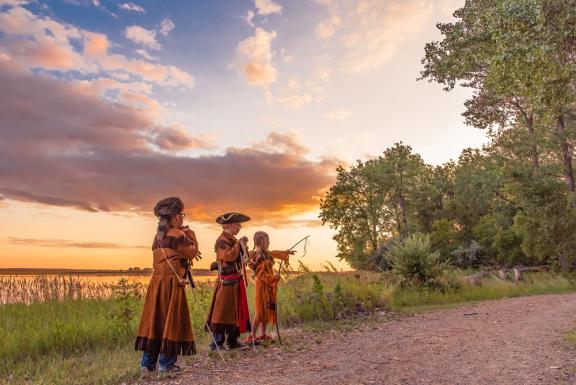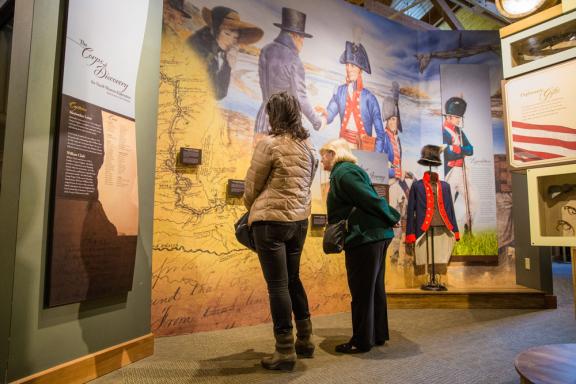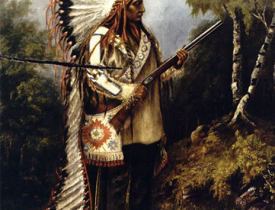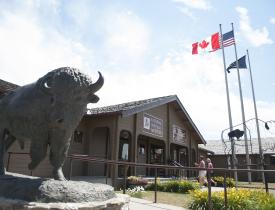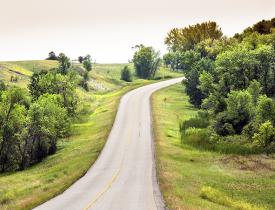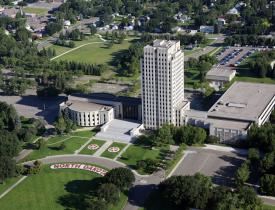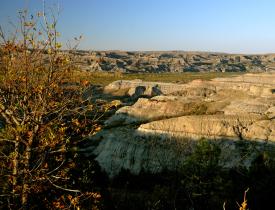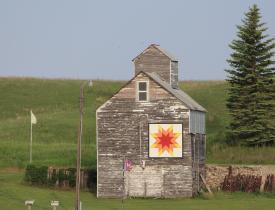Legendary Lewis and Clark Expedition Characters
Learn about the notable figures who shaped Lewis and Clark's famous journey into the unknown.
These legendary characters organized and led the Corps of Discovery on the famous Lewis & Clark Expedition.
Meriwether Lewis
The Lewis and Jefferson families were long-time neighbors and family friends. Meriwether Lewis served as Thomas Jefferson’s personal aide prior to the expedition. Lewis had a lifetime’s experience as an outdoorsman, hunter and herbal medicine expert, all facts of which Jefferson was aware and influenced his decision to choose him as Corps leader.
While at the Great Falls of the Missouri River, Lewis reflected on how, at age 31, he felt he had not accomplished much in the way of aiding the advancement of the human race. In September 1809, Lewis set out for Washington D.C. to answer complaints about his actions as governor. On the way, he stopped at an inn called Grinder's Stand, about 70 miles (110 km) from Nashville, Tennessee on the Natchez Trace on October 10, 1809. The next morning, servants found Lewis badly injured from multiple gunshot wounds. He died shortly after sunrise.
While modern historians generally accept his death as a suicide, there is some debate. Mrs. Grinder, the tavern-keeper's wife, claimed Lewis acted strangely the night before his death. She said that during dinner Lewis stood and paced about the room talking to himself in the way one would speak to a lawyer. She observed his face to flush as if it had come on him in a fit. After he retired for the evening, Mrs. Grinder continued to hear him talking to himself. At some point in the night she heard multiple gunshots, and what she believed was someone asking for help. She claimed to be able to see Lewis through the slit in the door crawling back to his room. She never explained why, at the time, she didn't investigate further concerning Lewis's condition or the source of the gunshots. The next morning, she sent for Lewis's servants, who found him weltering in his blood but alive for several hours.
When Clark and Jefferson were informed of Lewis' death, both accepted it as suicide, but his family contended it was murder. In later years a court of inquiry explored whether they could charge the tavern-keeper with Lewis' death. They dropped the inquiry for lack of evidence or motive.
Four years after Lewis' death, Thomas Jefferson wrote: “Of courage undaunted, possessing a firmness and perseverance of purpose which nothing but impossibilities could divert from its direction, ... honest, disinterested, liberal, of sound understanding and a fidelity to truth so scrupulous that whatever he should report would be as certain as if seen by ourselves, with all these qualifications as if selected and implanted by nature in one body for this express purpose, I could have no hesitation in confiding the enterprise to him.”
The explorer was buried not far from where he died, honored today by a memorial along the Natchez Trace Parkway.
William Clark
William Clark was born in Caroline County, Virginia, on August 1, 1770, the ninth of the 10 children of John and Ann Rogers Clark. Clark was also an adjutant and quartermaster while in the militia. He resigned his commission on July 1, 1796 and retired due to poor health, returning to Mulberry Hill, his family plantation near Louisville.
Prior to his resignation, Meriwether Lewis was assigned to Clark's unit as an ensign under Clark's command. In 1803, Clark was asked by Lewis to share command of the newly-formed Corps of Discovery. Clark spent three years on the expedition, and although technically subordinate to Lewis in rank, he exercised equal authority at Lewis' insistence. He concentrated chiefly on the drawing of maps, the management of the expedition's supplies and leading hunts.
After the Expedition, he served in a militia and as governor of the Missouri Territory. From 1822 until his death he held the position of Superintendent of Indian Affairs. Clark married Julia Hancock on January 5, 1808, at Fincastle, Virginia, and they had five children. Julia died in 1820 and William Clark then married her first cousin Harriet Kennerly Radford, and they had three children. His second wife died in 1831.
Clark died in St. Louis on September 1, 1838, and was buried in the Bellefontaine Cemetery, where a 35-foot gray granite obelisk was erected to mark his grave. Although his family had established endowments to maintain his grave site, by the late 20th century the grave site had fallen into disrepair. His descendants raised $100,000 to rehabilitate the obelisk and celebrated the re-dedication with a ceremony May 21, 2004, on the bicentennial of the start of his famous expedition. The ceremony was attended by a large gathering of his descendants, re-enactors in period dress, and leaders from the Osage Nation, and the Lemhi band of the Shoshone Native American people.
Thomas Jefferson
Thomas Jefferson was the third President of the United States (1801–1809), the principle author of the Declaration of Independence (1776), and one of the most influential Founding Fathers for his promotion of the ideals of republicanism in the United States. Major events during his presidency include the Louisiana Purchase (1803) and the Lewis and Clark Expedition (1804–1806).
As a political philosopher, Jefferson was a man of the Enlightenment and knew many intellectual leaders in Britain and France. A man of many talents, Jefferson achieved distinction as, among other things, a horticulturist, statesman, architect, archaeologist, inventor and founder of the University of Virginia. When President John F. Kennedy welcomed 49 Nobel Prize winners to the White House in 1962 he said, "I think this is the most extraordinary collection of talent and of human knowledge that has ever been gathered together at the White House – with the possible exception of when Thomas Jefferson dined alone." To date, Jefferson is the only president to serve two full terms in office and to veto no bill of Congress. Jefferson has been consistently ranked by scholars as one of the greatest U.S. presidents.
York
York was born in Caroline County near Ladysmith, Virginia. He was William Clark's servant from boyhood, and was left to William in his father's will. He had a wife, and possibly a family, before the Lewis and Clark Expedition.
In 1804, York was compelled to leave his family and accompany Clark and 40 others on the Lewis and Clark Expedition. The expedition's journals present York as a large, strong man who shared the duties and risks of the expedition in full. He was the only African American member of the Lewis and Clark Expedition, and in the wilderness served as an equal member, with freedoms and responsibilities unlike back East. The assignments given him, as recorded in the journals, attest to his skill in scouting, hunting and field medicine.
When the expedition reached the Pacific Ocean, York voted along with the rest as to where the Expedition would build winter quarters. Most significantly, at a time in which slaves were forbidden to carry weapons, York not only carried a firearm but also frequently shot game such as buffalo. York was never granted his freedom.
Sergeant Charles Floyd
Sergeant Floyd was born in Kentucky, and was among the first to volunteer for service in the Corps, joining on August 1, 1803. Among those included as one of the "Nine young men from Kentucky," Floyd was a cousin of the expedition's Sergeant Nathaniel Pryor. Considered a "man of much merit" by Captain Clark, he kept an uninterrupted daily record from May 14, 1804, until August 18, two days prior to his untimely death on August 20. Floyd's death was the only fatality among expedition members during the two years, four months and nine days of their transcontinental odyssey.
In the spirit of President Jefferson's instructions and perhaps drawing from an agrarian background, Floyd judged land quality, including soil conditions, en-route up the Missouri. Unfortunately, Floyd's contributions to the journey, together with his journal, ended with his premature death. As "Diagnosed" by the captains, Floyd's illness was considered to be a "bilious cholic."
Today, Floyd enjoys the honor of having had erected at his gravesite in present Sioux City, Iowa, the most prestigious memorial of the explorers. A 100-foot-high sandstone masonry obelisk, second in size only to that of the Washington Monument, was dedicated in fitting ceremonies on Memorial Day 1901. http://www.pbs.org/lewisandclark/inside/cfloy.html
Toussaint Charbonneau
Charbonneau was born in Boucherville, Quebec (near Montréal), a community with strong links to exploration and the fur trade.
It was likely that while working with the North West Company that Charbonneau encountered the established settlement of Mandan and Hidatsa tribes on the upper Missouri River, near present-day Bismarck, North Dakota. He settled amongst these tribes, according to his own report around 1797. The area would remain his home for the rest of his life. Charbonneau became a free agent, working on his own and for several different fur companies operating in the area, as a trapper, laborer and an interpreter of the Hidatsa language.
Soon after his arrival, Charbonneau purchased two captive Shoshone women: Sacagawea (Bird Woman) and "Otter Woman," from the Hidatsa, The Hidatsa had captured these two young women on one of their annual raiding and hunting parties to the west. Charbonneau eventually considered these women to be his wives, though whether they were bound through Native American custom or simply through common-law marriage is indeterminate.
In 1804 Sacagawea became pregnant with their first child. It was during this year that Meriwether Lewis and William Clark came to the area, built Fort Mandan, and recruited members to the Corps of Discovery. Charbonneau was interviewed to interpret Hidatsa. Lewis and Clark, however, were not overly impressed with him; Charbonneau spoke no English. Although several in the expedition party could translate from French, Charbonneau did not appear to know Hidatsa all that well. (By his own admission, over thirty years later, he still could not speak the language well although he had lived with the Hidatsa nearly continuously.) However, when Lewis and Clark learned that his wives were Shoshone, they were eager to have them interpret this language as well. Sacagawea spoke Shoshone and Hidatsa, and Charbonneau Hidatsa and French. They hired Charbonneau on November 4, and he and Sacagawea moved into Fort Mandan a week later.
In the winter, as the expedition was preparing to get underway, Charbonneau had second thoughts about his role. He quit the expedition, having said he was dissatisfied that he would be required to stand guard, perform manual labor, etc. But, on March 17 he returned and apologized, saying he would like to re-join the company; he was re-hired the following day. At age 47, Charbonneau was the oldest member of the expedition. His performance during the journey was mixed: Meriwether Lewis called him "a man of no peculiar merit," and many historians painted Charbonneau in a distinctly unfavorable light.
Charbonneau, however, did make several contributions to the success of the expedition. He was helpful when the expedition encountered French trappers from Canada. He served as a cook; his recipe for boudin blanc (a sausage made from bison meat) was praised by several members of the party. Additionally, his skill in striking a bargain came in handy when the expedition acquired much-needed horses at the Shoshone encampment.
Sakakawea (Sacagawea)
Sacagawea was born into the Lemhi Shoshone tribe in Idaho. In 1800, when she was about twelve, she and several other girls were kidnapped by a group of Hidatsa (also known as Minnetarees) in a battle that resulted in the death of four Shoshone men, four women and several boys. She was then taken to a Hidatsa village near present-day Washburn, North Dakota.
At about 13 years of age, Sacagawea was taken as a wife by Toussaint Charbonneau, a French trapper living in the village, who had also taken another young Shoshone wife named Otter Woman. Charbonneau is said to have won both wives from the Hidatsa while gambling. Sacagawea was pregnant with her first child when the Corps of Discovery arrived near the Hidatsa villages to spend the winter of 1805-1806. Captains Meriwether Lewis and William Clark built Fort Mandan and interviewed several trappers who might be able to translate or guide the expedition further up the Missouri River in the springtime. They agreed to hire Charbonneau as an interpreter when they discovered his wife spoke the Shoshone language, as they knew they would need the help of the Shoshone tribes at the headwaters of the Missouri.
Lewis recorded the birth of Jean Baptiste Charbonneau on February 11, 1805, noting that another of the party's interpreters administered crushed rattlesnake rattles from Lewis' specimen collection to speed the delivery. The boy was called "Little Pomp" or "Pompy" by Clark and others in the expedition.
In April, the expedition left Fort Mandan and headed up the Missouri River in pirogues, which had to be poled and sometimes pulled from the riverbanks. On May 14, 1805, Sacagawea rescued items that had fallen out of a capsized boat, including the journals and records of Lewis and Clark. The corps commanders, who praised her quick action on this occasion, would name the Sacagawea River in her honor on May 20.
When the corps reached the Pacific Ocean at last, all members of the expedition—including Sacagawea and Clark's black manservant York—were allowed to participate in a November 24 vote on the location where they would build their fort for the winter.
On the return trip, they approached the Rocky Mountains in July 1806. On July 6, Clark recorded "The Indian woman informed me that she had been in this plain frequently and knew it well.... She said we would discover a gap in the mountains in our direction..." which is now Gibbons Pass. A week later, on July 13, Sacagawea advised Clark to cross into the Yellowstone River basin at what is now known as Bozeman Pass, later chosen as the optimal route for the Northern Pacific Railway to cross the continental divide. While Sacagawea often appears in romantic depictions as a guide for the expedition, she provided direction in only a few instances. Her translation efforts also helped the party to negotiate with the Shoshone. However, her greatest value to the mission may have been simply her presence, which indicated their peaceful intent. While traveling through what is now Franklin County, Washington, Clark noted "The Indian woman confirmed those people of our friendly intentions, as no woman ever accompanies a war party of Indians in this quarter" and "the wife of Shabono our interpreter we find reconsiles all the Indians, as to our friendly intentions a woman with a party of men is a token of peace."
After the expedition, Charbonneau and Sacagawea spent three years among the Hidatsa before accepting William Clark's invitation to settle in St. Louis, Missouri in 1809. They entrusted Jean-Baptiste's education to Clark, who enrolled the young man in the Saint Louis Academy boarding school.
http://en.wikipedia.org/wiki/Sacagawea#Biography
Jean Baptiste Charbonneau (Pomp)
Jean Baptiste Charbonneau was born at Fort Mandan in North Dakota, the encampment at which the Lewis and Clark Expedition wintered in 1804-1805. His father, French Canadian trapper Toussaint Charbonneau, had been hired by the expedition as an interpreter. Captains Lewis and Clark agreed to bring along his then-pregnant Native American wife Sacagawea when they learned she was of the Shoshone people, as they knew they would need to negotiate with the Shoshone for horses and guides at the headwaters of the Missouri River. Meriwether Lewis noted the boy's birth in his journal:
“The party that were ordered last evening set out early this morning. the weather was fair and could wind N. W. about five o'clock this evening one of the wives of Charbono was delivered of a fine boy. it is worthy of remark that this was the first child which this woman had boarn and as is common in such cases her labour was tedious and the pain violent; Mr. Jessome informed me that he had frequently administered a small portion of the rattle of the rattle-snake, which he assured me had never failed to produce the desired effect, that of hastening the birth of the child; having the rattle of a snake by me I gave it to him and he administered two rings of it to the woman broken in small pieces with the fingers and added to a small quantity of water. Whether this medicine was truly the cause or not I shall not undertake to determine, but I was informed that she had not taken it more than ten minutes before she brought forth perhaps this remedy may be worthy of future experiments, but I must confess that I want faith as to it's [sic] efficacy.”
Charbonneau traveled from North Dakota to the Pacific Ocean and back as an infant, carried along in the expedition's boats or upon his mother's back. His presence is often credited with reassuring the native tribes the expedition encountered, as it is said they believed that no war party would travel with a woman and child.
Clark paid for young Jean Baptiste to attend school there at St. Louis Academy, now known as St. Louis University High School, and continued to oversee his care and schooling. Sakakawea returned up the Missouri River with the elder Charbonneau. In May 1866, while en route from California to the new gold fields around Virginia City, Montana, Charbonneau died of pneumonia near Danner, Oregon, at age 61.
http://en.wikipedia.org/wiki/Jean_Baptiste_Charbonneau
Seaman, the dog
Seaman, a black Newfoundland dog, became famous for being a member of the first American overland expedition from the Atlantic coast to the Pacific coast and back. He was purchased for $20 by Captain Meriwether Lewis for his famed Lewis and Clark expedition. During the expedition, around May 14, 1805, both Captains performed surgery on one of Seaman's arteries in his hind leg, as it had been severed by a beaver bite. In early 1806, as the expedition was beginning the return journey, Seaman was stolen by Indians and Lewis threatened to send three armed men to kill the Indian tribe.
Bibliography: http://en.wikipedia.org/wiki/Lewis_and_Clark_Expedition
A Journey into the Unknown
The Corps of Discovery entered North Dakota in mid-October, 1804, wintered here and ventured west in April 1805, stepping off the map of the know world. Some of the most important and dramatic events of their journey happened here, particularly meeting a young Indian woman named Sakakawea (Sacagawea). She lived in a settlement of 4,500 people now known as the Knife River Indian Villages. The populations of the villages was greater than the cities of Washington D. C. and St. Louis at the that time.
Lewis and Clark spent the winter among five Mandan and Hidatsa earthlodge villages, located at or just below the mouth of the Knife River where they constructed Fort Mandan, named in honor of their new friends on the plains. During their time at Fort Mandan, Captain Lewis hired Sakakawea’s husband, Toussaint Charbonneau, “with his wife, as an interpreter” and later helped deliver her son, Jean Baptiste.
Sakakawea’s mere presence on the expedition, with a baby in tow, announced in a universal language that theirs was a peaceful mission. Her story is fascinating and complex; its details often unclear. But one thing is certain: She could not have imagined the place she was about to carve for herself in history.

